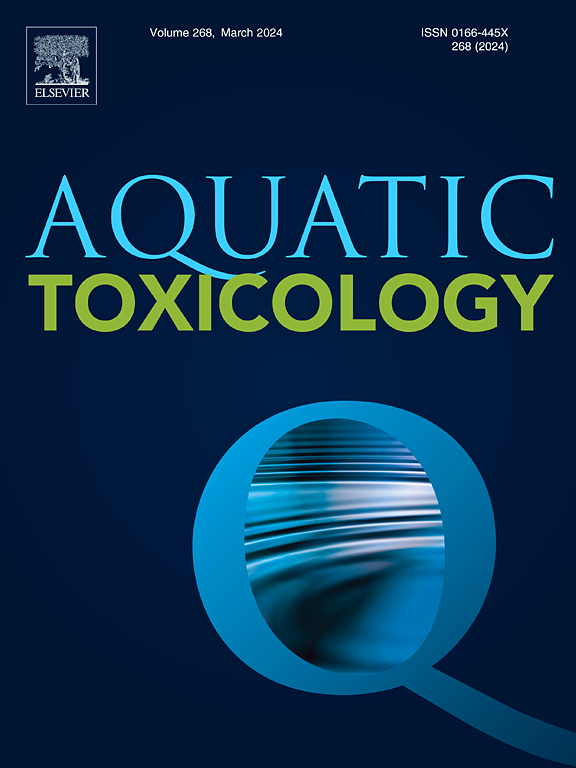淡水食物链中膳食纳米粒铈生物利用度低的证据
IF 4.1
2区 环境科学与生态学
Q1 MARINE & FRESHWATER BIOLOGY
引用次数: 0
摘要
采用天然河水和合成淡水中与天然和人工饲料相关的离子(I-Ce)、纳米(N-Ce,平均初级粒径为11±9 nm±标准差)和微米(m - ce, 530±440µm)形式的放射性141Ce,测量了淡水食物链中饲料中141Ce同化的实时生物动力学。模型食物链由微藻(Raphidocelis subcapitata)、蜗牛(Potamopyrgus antipodarum)和对虾(Macrobrachium australiense)组成。脉冲追踪实验表明,在24 h内,与所有饲料和水类型相关的91 - 100%的各种形式的铈从蜗牛和对虾的消化系统中被消除,没有检测到铈的同化。对虾和蜗牛对所有形式铈的中位消除时间(ET50)和消除率(Ke)分别为0.05 ~ 1.7 d和30 ~ 100% / d。脉冲追踪结果得到了N-Ce和M-Ce的放射自显影证据的支持,这些证据证实,随着时间的推移,对虾的组织内没有可检测到的同化和移位。相比之下,在对虾的肝胰脏中发现了较易溶解的低量I-Ce,这证实了在这些生物体的消化环境中缺乏N-Ce和M-Ce的溶解使得这些形式的生物利用度较低。此外,N-Ce和M-Ce的异团聚导致颗粒不能在消化液中解离,并且太大而无法被吸收,从而使它们不能被生物利用。根据本研究结果和文献综述,淡水生态系统中N-Ce生物放大和慢性膳食毒性的风险并不大于与M-Ce或I-Ce相关的风险。本文章由计算机程序翻译,如有差异,请以英文原文为准。

Evidence for low bioavailability of dietary nanoparticulate cerium in a freshwater food chain
Radioactive 141Ce in ionic (I-Ce), nano (N-Ce, 11 ± 9 nm mean primary particle size ± standard deviation) and micron-sized (M-Ce, 530 ± 440 µm) forms associated with natural and artificial diets in natural river water and synthetic freshwater were used to measure the real-time biokinetics of dietary 141Ce assimilation in a freshwater food chain. The model food chain consisted of microalgae (Raphidocelis subcapitata), snails (Potamopyrgus antipodarum) and prawns (Macrobrachium australiense). Pulse-chase experiments showed that 91–100 % of all forms of cerium associated with all diets and water types were eliminated from the digestive system of the snail and prawn within 24 h, with no detectable cerium assimilation. The prawn and snail median elimination times (ET50) and elimination rates (Ke) for all cerium forms ranged from 0.05 to 1.7 d, and 30 to >100 % per d, respectively. The pulse-chase results were supported by the autoradiographic evidence for N-Ce and M-Ce that confirmed no detectable assimilation and translocation within the tissue of the prawn over time. In contrast, the more soluble I-Ce was found to be associated in low quantities with the hepatopancreas in the prawn confirming that the lack of dissolution by N-Ce and M-Ce in the digestive environment of these organisms makes these forms less bioavailable. In addition, hetero-agglomeration of N-Ce and M-Ce resulted in particles that did not dissociate in digestive fluids and were too large to be assimilated thereby making them non-bioavailable. Based on the results from this study and from the literature review, the risk of N-Ce biomagnification and chronic dietary toxicity in freshwater ecosystems is no greater than the risk associated with M-Ce or I-Ce.
求助全文
通过发布文献求助,成功后即可免费获取论文全文。
去求助
来源期刊

Aquatic Toxicology
环境科学-毒理学
CiteScore
7.10
自引率
4.40%
发文量
250
审稿时长
56 days
期刊介绍:
Aquatic Toxicology publishes significant contributions that increase the understanding of the impact of harmful substances (including natural and synthetic chemicals) on aquatic organisms and ecosystems.
Aquatic Toxicology considers both laboratory and field studies with a focus on marine/ freshwater environments. We strive to attract high quality original scientific papers, critical reviews and expert opinion papers in the following areas: Effects of harmful substances on molecular, cellular, sub-organismal, organismal, population, community, and ecosystem level; Toxic Mechanisms; Genetic disturbances, transgenerational effects, behavioral and adaptive responses; Impacts of harmful substances on structure, function of and services provided by aquatic ecosystems; Mixture toxicity assessment; Statistical approaches to predict exposure to and hazards of contaminants
The journal also considers manuscripts in other areas, such as the development of innovative concepts, approaches, and methodologies, which promote the wider application of toxicological datasets to the protection of aquatic environments and inform ecological risk assessments and decision making by relevant authorities.
 求助内容:
求助内容: 应助结果提醒方式:
应助结果提醒方式:


